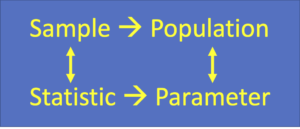Parametric Statistics
Parameters, statistics, populations, and samples

We read the illustration above as: a sample is to a population as a statistic is to a parameter.
Here we demonstrate the transitive relationship between samples and populations using parameters and statistics. That is, when we are working within a parametric statistical paradigm we apply inference to establish the relationship between that which we calculate for a sample and that which we intend to represent for a population.
We never know a parameter, because we never measure the population, but we estimate the parameter with the statistics that we compute. Further, we can never measure the entire population rather, we collect a sample, which we deem to be representative of the population and then calculate statistics that represent the parameter of interest within the population.
For example, let’s say we wish to calculate the average age of all residents in Long Term Care Homes in the Province of Prince Edward Island. In such an example, the group of all residents will be considered the population. However, knowing that we don’t have the capability (time or permission) to visit every resident in the Long Term Care homes in PEI, instead, we randomly choose a few residences and arrange to visit these specific locations so that we can ask the residents their age.
Moving along in this quest we realize that not every resident is interested in our exercise and so has no intention to tell us their age. At the end of the day, the ages that we actually recorded represent our sample of data, and we assume that, given our best attempts to record the ages of all residents in the Long Term Care Homes, our final data set is a representative sample of the population of all residents in Long Term Care Homes in the Province of Prince Edward Island.
Therefore, the average age that we estimate for this sample is referred to as a statistic and is presented with the symbol [latex]\bar{x}[/latex]. Further, given that we are working within a parametric statistical paradigm we infer that the calculated statistic is a representative estimate of the parameter for the average age of the population which is represented by the symbol [latex]{\mu}[/latex].
In the following sections, we will explore parametric applications in the context of applied statistics in healthcare.

